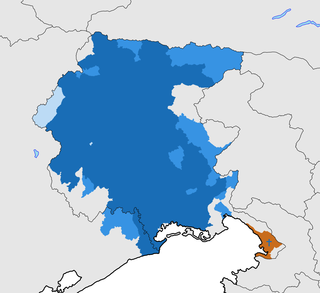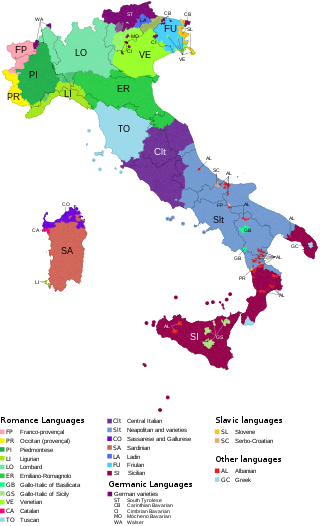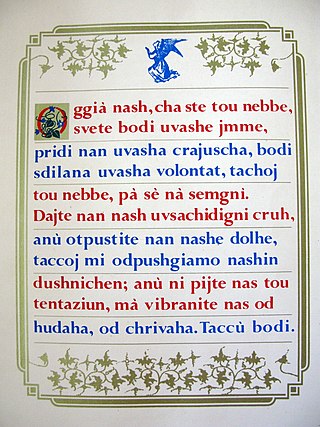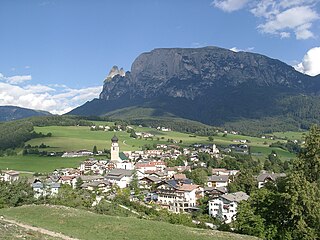Related Research Articles

Romansh is a Gallo-Romance and/or Rhaeto-Romance language spoken predominantly in the Swiss canton of the Grisons (Graubünden). Romansh has been recognized as a national language of Switzerland since 1938, and as an official language in correspondence with Romansh-speaking citizens since 1996, along with German, French, and Italian. It also has official status in the canton of the Grisons alongside German and Italian and is used as the medium of instruction in schools in Romansh-speaking areas. It is sometimes grouped by linguists with Ladin and Friulian as the Rhaeto-Romance languages, though this is disputed.

Ladin is a Romance language of the Rhaeto-Romance subgroup, mainly spoken in the Dolomite Mountains in Northern Italy in the provinces of South Tyrol, Trentino, and Belluno, by the Ladin people. It exhibits similarities to Romansh, spoken in Switzerland, as well as Friulian, spoken in north-east Italy.

Friulian or Friulan is a Romance language belonging to the Rhaeto-Romance family, spoken in the Friuli region of northeastern Italy. Friulian has around 600,000 speakers, the vast majority of whom also speak Italian. It is sometimes called Eastern Ladin since it shares the same roots as Ladin, but over the centuries, it has diverged under the influence of surrounding languages, including German, Italian, Venetian, and Slovene. Documents in Friulian are attested from the 11th century and poetry and literature date as far back as 1300. By the 20th century, there was a revival of interest in the language.
The Istriot language is a Romance language of the Italo-Dalmatian branch spoken by about 400 people in the southwestern part of the Istrian peninsula in Croatia, particularly in Rovinj and Vodnjan. It should not be confused with the Istrian dialect of the Venetian language or the more distantly related Istro-Romanian, a variety of Eastern Romance.

Rhaeto-Romance, Rheto-Romance, Rhaeto-Italian,or Rhaetian, is a purported subfamily of the Romance languages that is spoken in south-eastern Switzerland and north-eastern Italy. The name "Rhaeto-Romance" refers to the former Roman province of Raetia. The question of whether these languages actually form a subfamily is called the Questione Ladina. The Italian linguist Graziadio Ascoli, writing in 1873, found them to share a number of intricacies and believed they formed a linguistic group. The Rhaeto-Romance languages differ from Italian in their evolution from Latin by having passed through a stage with phonemic vowel length, undergone certain consonant developments, and possibly developed a pair of central rounded vowels. If the subfamily is genuine, three languages would belong to it: Romansh in Switzerland, and Ladin and Friulian in Italy. Their combined number of speakers is about 660,000; the large majority of these speak Friulian.

Griko, sometimes spelled Grico, is one of the two dialects of Italiot Greek, spoken by Griko people in Salento, province of Lecce, Italy. Some Greek linguists consider it to be a Modern Greek dialect and often call it Katoitaliótika or Grekanika (Γραικάνικα). Griko and Standard Modern Greek are partially mutually intelligible.

The languages of Italy include Italian, which serves as the country's national language, in its standard and regional forms, as well as numerous local and regional languages, most of which, like Italian, belong to the broader Romance group. The majority of languages often labeled as regional are distributed in a continuum across the regions' administrative boundaries, with speakers from one locale within a single region being typically aware of the features distinguishing their own variety from one of the other places nearby.

The Resian dialect or simply Resian is a distinct variety in the South Slavic continuum, generally considered a Slovene dialect spoken in the Resia Valley, Province of Udine, Italy, close to the border with Slovenia.

Forni di Sopra is a town and comune (municipality) in the Regional decentralization entity of Udine in the region of Friuli-Venezia Giulia, northeast Italy. It is located on the Dolomite Alps mountain range in northeastern Italy, at the top of the Tagliamento river valley.

Völs am Schlern, often abbreviated to Völs, is a municipality in South Tyrol in northern Italy. It is located at the foot of the Schlern mountain, about 12 kilometres (7 mi) east of Bolzano.
San Nicolò di Comelico is a comune (municipality) in the province of Belluno in the Italian region of Veneto, located about 130 kilometres (81 mi) north of Venice.

Sappada is a comune (municipality) in the Regional decentralization entity of Udine, in the Italian region of Friuli-Venezia Giulia. It is one of I Borghi più belli d'Italia.

Forni Avoltri is a comune (municipality) in the Regional decentralization entity of Udine in the Italian region of Friuli-Venezia Giulia, located about 130 kilometres (81 mi) northwest of Trieste and about 70 kilometres (43 mi) northwest of Udine, on the border with Austria. As of 31 December 2004, it had a population of 704 and an area of 80.8 square kilometres (31.2 sq mi).

Sauris is a comune (municipality) in the Regional decentralization entity of Udine in the Italian region of Friuli-Venezia Giulia. At an elevation of 1,212 m (3,976 ft), it is the second highest municipality in the region and one of the German language islands in Northeast Italy. Sauris is part of the Alpine pearls cooperation for sustainable tourism.

Erto e Casso is a comune (municipality) in the Regional decentralization entity of Pordenone in the Italian region of Friuli-Venezia Giulia, located about 130 kilometres (81 mi) northwest of Trieste and about 40 kilometres (25 mi) northwest of Pordenone.

Carnia is a historical-geographic region in the northeastern Italian area of Friuli. Its 27 municipalities all belong to the province of Udine, which itself is part of the autonomous Friuli-Venezia Giulia region.

Cadorino, a dialect of Ladin, is the language of Cadore, at the feet of the Dolomites in the province of Belluno. It is distinct from neighboring dialects, and though it has received relatively little attention, it is important to an understanding of the linguistic history of northern Italy.

The Questione Ladina is a controversy over whether the Romance languages of Romansh, Ladin, and Friulian form a proper language subfamily or should rather be regarded as a part of a wider Northern Italian dialect continuum. Both the idea of a distinctive language sub-family and the denial of a Ladin unity still have strong proponents, the former especially among Swiss, German and Austrian, the latter among Italian linguists. The issue has political implications beyond the linguistic controversy, as the areas involved have been subjects of territorial disputes, especially during the first half of the 20th century.

Gianfrancesco da Tolmezzo, also known as Gianfranco del Zotto, was born in Socchieve and lived from 1450 to 1510. He is considered to be one of the founders of the Tolmezzo school of painting and was one of the leading exponents of Friulian art in the 15th century. Works of his survive at the parish church of Provesano in San Giorgio della Richinvelda, and at Castel d'Aviano, Budoia, Pordenone, Cordenons, Vivaro, Forni di Sotto, Forni di Sopra, and his birth town of Socchieve.
References
- ↑ Videsott, Paul (2011). "Rheto-Romance Studies". The Year's Work in Modern Language Studies. 71: 530–542. doi:10.5699/yearworkmodlang.71.2009.0530. ISSN 0084-4152. JSTOR 10.5699/yearworkmodlang.71.2009.0530.